International Finance: Developments, Impact on Barclays Bank, MNE's Strategy, Financial Ratios
VerifiedAdded on 2023/01/19
|11
|3230
|80
AI Summary
This document discusses the developments in the international financial environment and its impact on Barclays Bank. It also explores the essential elements of MNE's international financial and risk management strategy. Additionally, it evaluates financial ratios and accounting ratios to analyze the financial performance of the bank. Subject: International Finance
Contribute Materials
Your contribution can guide someone’s learning journey. Share your
documents today.

International Finance
Secure Best Marks with AI Grader
Need help grading? Try our AI Grader for instant feedback on your assignments.
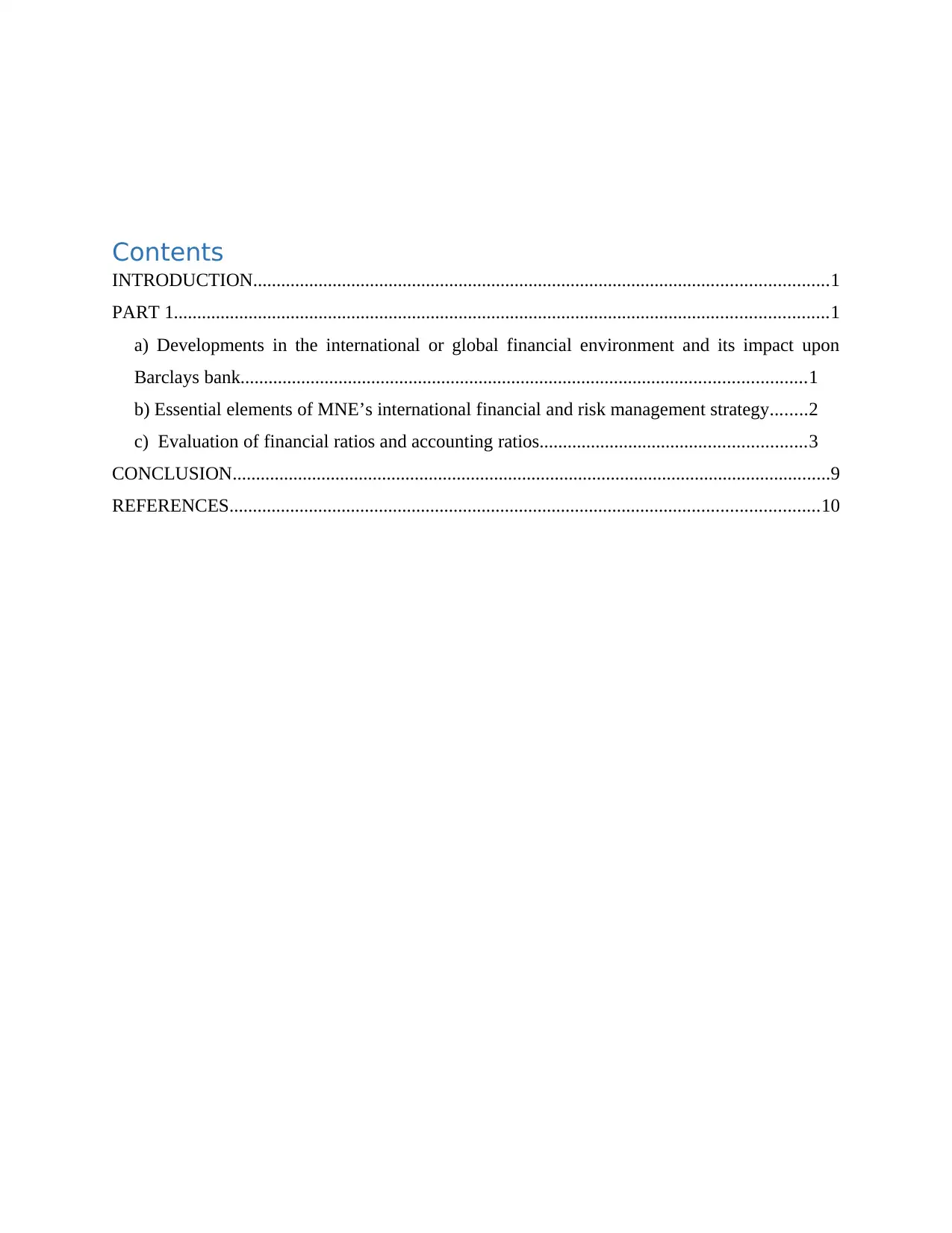
Contents
INTRODUCTION...........................................................................................................................1
PART 1............................................................................................................................................1
a) Developments in the international or global financial environment and its impact upon
Barclays bank.........................................................................................................................1
b) Essential elements of MNE’s international financial and risk management strategy........2
c) Evaluation of financial ratios and accounting ratios.........................................................3
CONCLUSION................................................................................................................................9
REFERENCES..............................................................................................................................10
INTRODUCTION...........................................................................................................................1
PART 1............................................................................................................................................1
a) Developments in the international or global financial environment and its impact upon
Barclays bank.........................................................................................................................1
b) Essential elements of MNE’s international financial and risk management strategy........2
c) Evaluation of financial ratios and accounting ratios.........................................................3
CONCLUSION................................................................................................................................9
REFERENCES..............................................................................................................................10
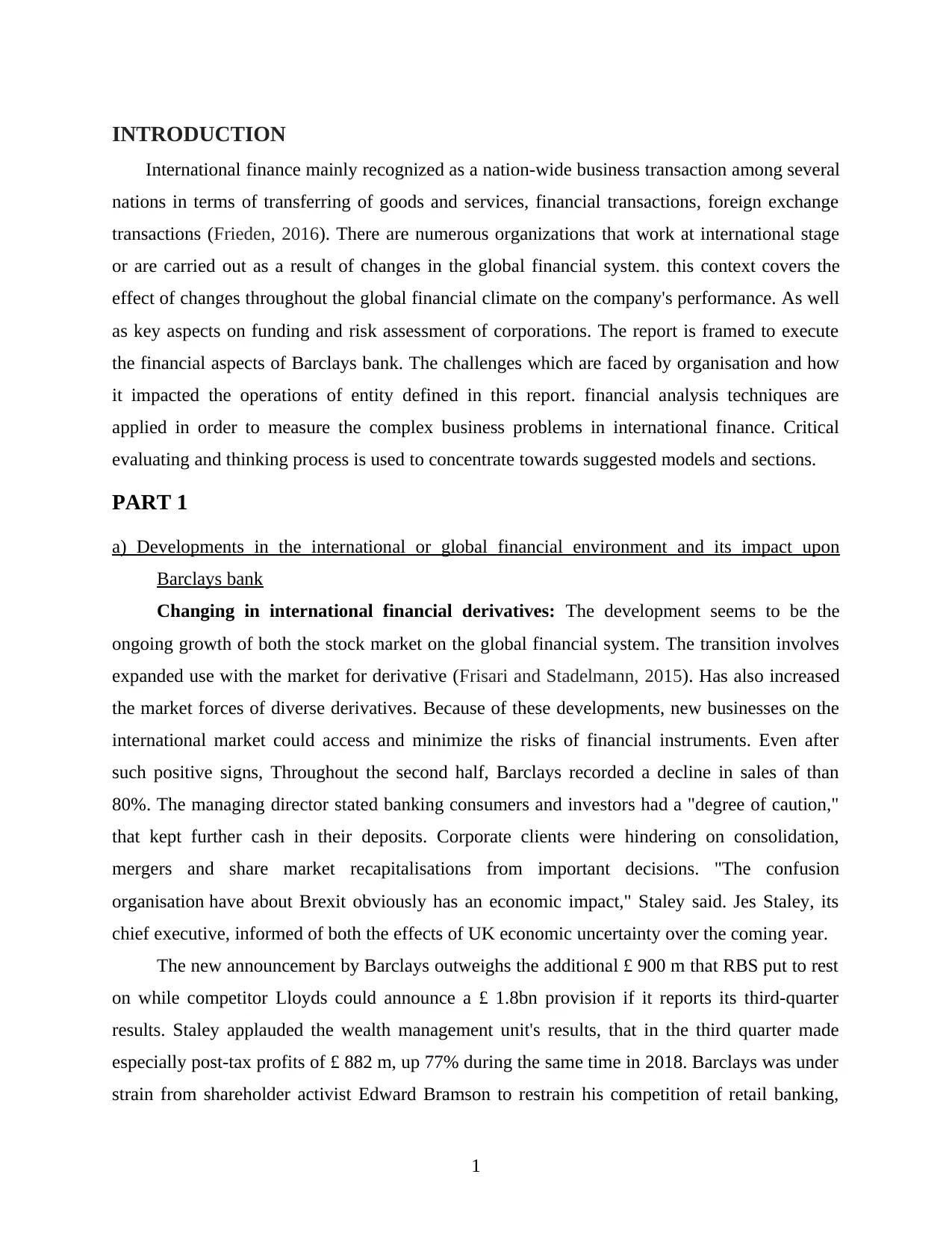
INTRODUCTION
International finance mainly recognized as a nation-wide business transaction among several
nations in terms of transferring of goods and services, financial transactions, foreign exchange
transactions (Frieden, 2016). There are numerous organizations that work at international stage
or are carried out as a result of changes in the global financial system. this context covers the
effect of changes throughout the global financial climate on the company's performance. As well
as key aspects on funding and risk assessment of corporations. The report is framed to execute
the financial aspects of Barclays bank. The challenges which are faced by organisation and how
it impacted the operations of entity defined in this report. financial analysis techniques are
applied in order to measure the complex business problems in international finance. Critical
evaluating and thinking process is used to concentrate towards suggested models and sections.
PART 1
a) Developments in the international or global financial environment and its impact upon
Barclays bank
Changing in international financial derivatives: The development seems to be the
ongoing growth of both the stock market on the global financial system. The transition involves
expanded use with the market for derivative (Frisari and Stadelmann, 2015). Has also increased
the market forces of diverse derivatives. Because of these developments, new businesses on the
international market could access and minimize the risks of financial instruments. Even after
such positive signs, Throughout the second half, Barclays recorded a decline in sales of than
80%. The managing director stated banking consumers and investors had a "degree of caution,"
that kept further cash in their deposits. Corporate clients were hindering on consolidation,
mergers and share market recapitalisations from important decisions. "The confusion
organisation have about Brexit obviously has an economic impact," Staley said. Jes Staley, its
chief executive, informed of both the effects of UK economic uncertainty over the coming year.
The new announcement by Barclays outweighs the additional £ 900 m that RBS put to rest
on while competitor Lloyds could announce a £ 1.8bn provision if it reports its third-quarter
results. Staley applauded the wealth management unit's results, that in the third quarter made
especially post-tax profits of £ 882 m, up 77% during the same time in 2018. Barclays was under
strain from shareholder activist Edward Bramson to restrain his competition of retail banking,
1
International finance mainly recognized as a nation-wide business transaction among several
nations in terms of transferring of goods and services, financial transactions, foreign exchange
transactions (Frieden, 2016). There are numerous organizations that work at international stage
or are carried out as a result of changes in the global financial system. this context covers the
effect of changes throughout the global financial climate on the company's performance. As well
as key aspects on funding and risk assessment of corporations. The report is framed to execute
the financial aspects of Barclays bank. The challenges which are faced by organisation and how
it impacted the operations of entity defined in this report. financial analysis techniques are
applied in order to measure the complex business problems in international finance. Critical
evaluating and thinking process is used to concentrate towards suggested models and sections.
PART 1
a) Developments in the international or global financial environment and its impact upon
Barclays bank
Changing in international financial derivatives: The development seems to be the
ongoing growth of both the stock market on the global financial system. The transition involves
expanded use with the market for derivative (Frisari and Stadelmann, 2015). Has also increased
the market forces of diverse derivatives. Because of these developments, new businesses on the
international market could access and minimize the risks of financial instruments. Even after
such positive signs, Throughout the second half, Barclays recorded a decline in sales of than
80%. The managing director stated banking consumers and investors had a "degree of caution,"
that kept further cash in their deposits. Corporate clients were hindering on consolidation,
mergers and share market recapitalisations from important decisions. "The confusion
organisation have about Brexit obviously has an economic impact," Staley said. Jes Staley, its
chief executive, informed of both the effects of UK economic uncertainty over the coming year.
The new announcement by Barclays outweighs the additional £ 900 m that RBS put to rest
on while competitor Lloyds could announce a £ 1.8bn provision if it reports its third-quarter
results. Staley applauded the wealth management unit's results, that in the third quarter made
especially post-tax profits of £ 882 m, up 77% during the same time in 2018. Barclays was under
strain from shareholder activist Edward Bramson to restrain his competition of retail banking,
1
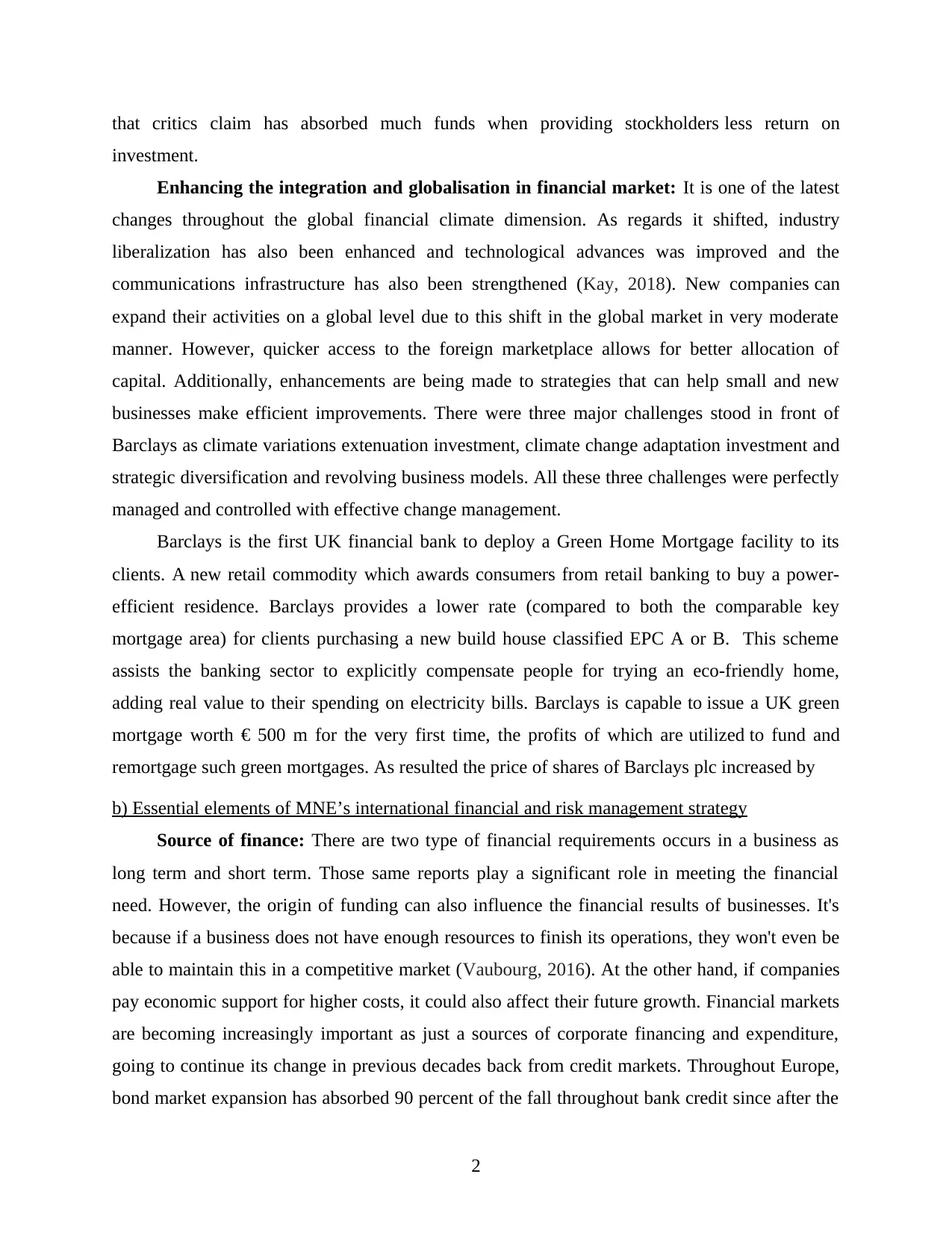
that critics claim has absorbed much funds when providing stockholders less return on
investment.
Enhancing the integration and globalisation in financial market: It is one of the latest
changes throughout the global financial climate dimension. As regards it shifted, industry
liberalization has also been enhanced and technological advances was improved and the
communications infrastructure has also been strengthened (Kay, 2018). New companies can
expand their activities on a global level due to this shift in the global market in very moderate
manner. However, quicker access to the foreign marketplace allows for better allocation of
capital. Additionally, enhancements are being made to strategies that can help small and new
businesses make efficient improvements. There were three major challenges stood in front of
Barclays as climate variations extenuation investment, climate change adaptation investment and
strategic diversification and revolving business models. All these three challenges were perfectly
managed and controlled with effective change management.
Barclays is the first UK financial bank to deploy a Green Home Mortgage facility to its
clients. A new retail commodity which awards consumers from retail banking to buy a power-
efficient residence. Barclays provides a lower rate (compared to both the comparable key
mortgage area) for clients purchasing a new build house classified EPC A or B. This scheme
assists the banking sector to explicitly compensate people for trying an eco-friendly home,
adding real value to their spending on electricity bills. Barclays is capable to issue a UK green
mortgage worth € 500 m for the very first time, the profits of which are utilized to fund and
remortgage such green mortgages. As resulted the price of shares of Barclays plc increased by
b) Essential elements of MNE’s international financial and risk management strategy
Source of finance: There are two type of financial requirements occurs in a business as
long term and short term. Those same reports play a significant role in meeting the financial
need. However, the origin of funding can also influence the financial results of businesses. It's
because if a business does not have enough resources to finish its operations, they won't even be
able to maintain this in a competitive market (Vaubourg, 2016). At the other hand, if companies
pay economic support for higher costs, it could also affect their future growth. Financial markets
are becoming increasingly important as just a sources of corporate financing and expenditure,
going to continue its change in previous decades back from credit markets. Throughout Europe,
bond market expansion has absorbed 90 percent of the fall throughout bank credit since after the
2
investment.
Enhancing the integration and globalisation in financial market: It is one of the latest
changes throughout the global financial climate dimension. As regards it shifted, industry
liberalization has also been enhanced and technological advances was improved and the
communications infrastructure has also been strengthened (Kay, 2018). New companies can
expand their activities on a global level due to this shift in the global market in very moderate
manner. However, quicker access to the foreign marketplace allows for better allocation of
capital. Additionally, enhancements are being made to strategies that can help small and new
businesses make efficient improvements. There were three major challenges stood in front of
Barclays as climate variations extenuation investment, climate change adaptation investment and
strategic diversification and revolving business models. All these three challenges were perfectly
managed and controlled with effective change management.
Barclays is the first UK financial bank to deploy a Green Home Mortgage facility to its
clients. A new retail commodity which awards consumers from retail banking to buy a power-
efficient residence. Barclays provides a lower rate (compared to both the comparable key
mortgage area) for clients purchasing a new build house classified EPC A or B. This scheme
assists the banking sector to explicitly compensate people for trying an eco-friendly home,
adding real value to their spending on electricity bills. Barclays is capable to issue a UK green
mortgage worth € 500 m for the very first time, the profits of which are utilized to fund and
remortgage such green mortgages. As resulted the price of shares of Barclays plc increased by
b) Essential elements of MNE’s international financial and risk management strategy
Source of finance: There are two type of financial requirements occurs in a business as
long term and short term. Those same reports play a significant role in meeting the financial
need. However, the origin of funding can also influence the financial results of businesses. It's
because if a business does not have enough resources to finish its operations, they won't even be
able to maintain this in a competitive market (Vaubourg, 2016). At the other hand, if companies
pay economic support for higher costs, it could also affect their future growth. Financial markets
are becoming increasingly important as just a sources of corporate financing and expenditure,
going to continue its change in previous decades back from credit markets. Throughout Europe,
bond market expansion has absorbed 90 percent of the fall throughout bank credit since after the
2
Secure Best Marks with AI Grader
Need help grading? Try our AI Grader for instant feedback on your assignments.
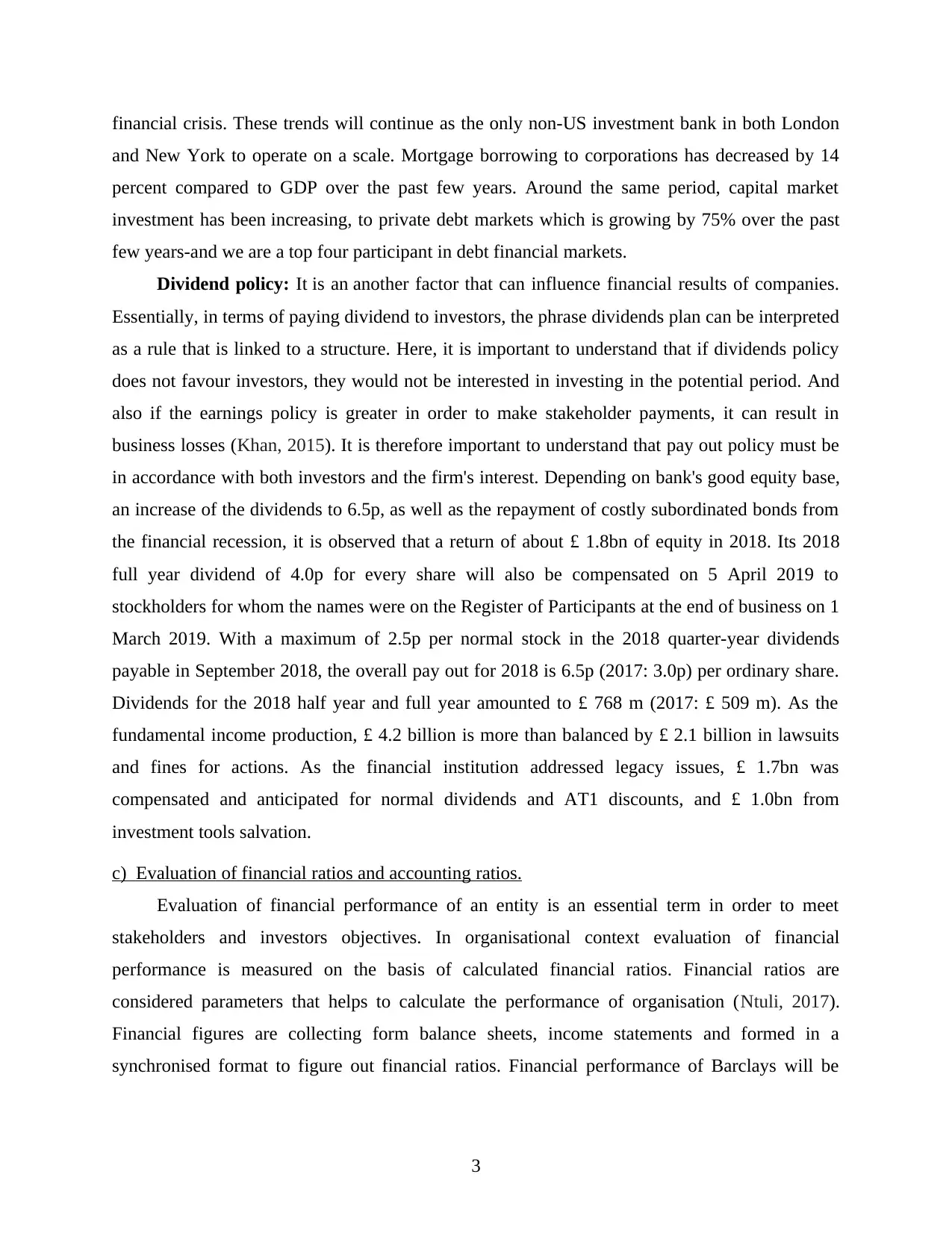
financial crisis. These trends will continue as the only non-US investment bank in both London
and New York to operate on a scale. Mortgage borrowing to corporations has decreased by 14
percent compared to GDP over the past few years. Around the same period, capital market
investment has been increasing, to private debt markets which is growing by 75% over the past
few years-and we are a top four participant in debt financial markets.
Dividend policy: It is an another factor that can influence financial results of companies.
Essentially, in terms of paying dividend to investors, the phrase dividends plan can be interpreted
as a rule that is linked to a structure. Here, it is important to understand that if dividends policy
does not favour investors, they would not be interested in investing in the potential period. And
also if the earnings policy is greater in order to make stakeholder payments, it can result in
business losses (Khan, 2015). It is therefore important to understand that pay out policy must be
in accordance with both investors and the firm's interest. Depending on bank's good equity base,
an increase of the dividends to 6.5p, as well as the repayment of costly subordinated bonds from
the financial recession, it is observed that a return of about £ 1.8bn of equity in 2018. Its 2018
full year dividend of 4.0p for every share will also be compensated on 5 April 2019 to
stockholders for whom the names were on the Register of Participants at the end of business on 1
March 2019. With a maximum of 2.5p per normal stock in the 2018 quarter-year dividends
payable in September 2018, the overall pay out for 2018 is 6.5p (2017: 3.0p) per ordinary share.
Dividends for the 2018 half year and full year amounted to £ 768 m (2017: £ 509 m). As the
fundamental income production, £ 4.2 billion is more than balanced by £ 2.1 billion in lawsuits
and fines for actions. As the financial institution addressed legacy issues, £ 1.7bn was
compensated and anticipated for normal dividends and AT1 discounts, and £ 1.0bn from
investment tools salvation.
c) Evaluation of financial ratios and accounting ratios.
Evaluation of financial performance of an entity is an essential term in order to meet
stakeholders and investors objectives. In organisational context evaluation of financial
performance is measured on the basis of calculated financial ratios. Financial ratios are
considered parameters that helps to calculate the performance of organisation (Ntuli, 2017).
Financial figures are collecting form balance sheets, income statements and formed in a
synchronised format to figure out financial ratios. Financial performance of Barclays will be
3
and New York to operate on a scale. Mortgage borrowing to corporations has decreased by 14
percent compared to GDP over the past few years. Around the same period, capital market
investment has been increasing, to private debt markets which is growing by 75% over the past
few years-and we are a top four participant in debt financial markets.
Dividend policy: It is an another factor that can influence financial results of companies.
Essentially, in terms of paying dividend to investors, the phrase dividends plan can be interpreted
as a rule that is linked to a structure. Here, it is important to understand that if dividends policy
does not favour investors, they would not be interested in investing in the potential period. And
also if the earnings policy is greater in order to make stakeholder payments, it can result in
business losses (Khan, 2015). It is therefore important to understand that pay out policy must be
in accordance with both investors and the firm's interest. Depending on bank's good equity base,
an increase of the dividends to 6.5p, as well as the repayment of costly subordinated bonds from
the financial recession, it is observed that a return of about £ 1.8bn of equity in 2018. Its 2018
full year dividend of 4.0p for every share will also be compensated on 5 April 2019 to
stockholders for whom the names were on the Register of Participants at the end of business on 1
March 2019. With a maximum of 2.5p per normal stock in the 2018 quarter-year dividends
payable in September 2018, the overall pay out for 2018 is 6.5p (2017: 3.0p) per ordinary share.
Dividends for the 2018 half year and full year amounted to £ 768 m (2017: £ 509 m). As the
fundamental income production, £ 4.2 billion is more than balanced by £ 2.1 billion in lawsuits
and fines for actions. As the financial institution addressed legacy issues, £ 1.7bn was
compensated and anticipated for normal dividends and AT1 discounts, and £ 1.0bn from
investment tools salvation.
c) Evaluation of financial ratios and accounting ratios.
Evaluation of financial performance of an entity is an essential term in order to meet
stakeholders and investors objectives. In organisational context evaluation of financial
performance is measured on the basis of calculated financial ratios. Financial ratios are
considered parameters that helps to calculate the performance of organisation (Ntuli, 2017).
Financial figures are collecting form balance sheets, income statements and formed in a
synchronised format to figure out financial ratios. Financial performance of Barclays will be
3
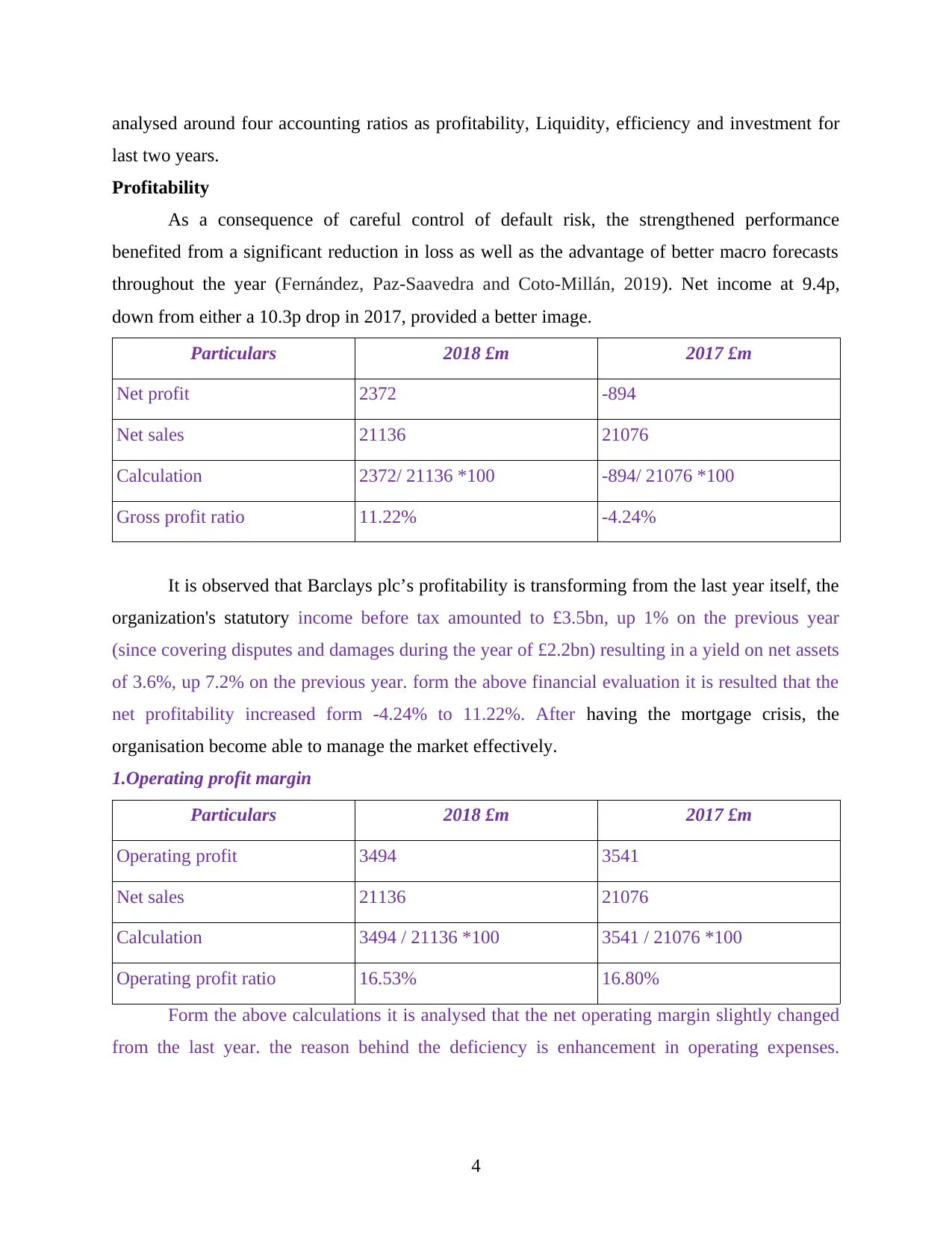
analysed around four accounting ratios as profitability, Liquidity, efficiency and investment for
last two years.
Profitability
As a consequence of careful control of default risk, the strengthened performance
benefited from a significant reduction in loss as well as the advantage of better macro forecasts
throughout the year (Fernández, Paz-Saavedra and Coto-Millán, 2019). Net income at 9.4p,
down from either a 10.3p drop in 2017, provided a better image.
Particulars 2018 £m 2017 £m
Net profit 2372 -894
Net sales 21136 21076
Calculation 2372/ 21136 *100 -894/ 21076 *100
Gross profit ratio 11.22% -4.24%
It is observed that Barclays plc’s profitability is transforming from the last year itself, the
organization's statutory income before tax amounted to £3.5bn, up 1% on the previous year
(since covering disputes and damages during the year of £2.2bn) resulting in a yield on net assets
of 3.6%, up 7.2% on the previous year. form the above financial evaluation it is resulted that the
net profitability increased form -4.24% to 11.22%. After having the mortgage crisis, the
organisation become able to manage the market effectively.
1.Operating profit margin
Particulars 2018 £m 2017 £m
Operating profit 3494 3541
Net sales 21136 21076
Calculation 3494 / 21136 *100 3541 / 21076 *100
Operating profit ratio 16.53% 16.80%
Form the above calculations it is analysed that the net operating margin slightly changed
from the last year. the reason behind the deficiency is enhancement in operating expenses.
4
last two years.
Profitability
As a consequence of careful control of default risk, the strengthened performance
benefited from a significant reduction in loss as well as the advantage of better macro forecasts
throughout the year (Fernández, Paz-Saavedra and Coto-Millán, 2019). Net income at 9.4p,
down from either a 10.3p drop in 2017, provided a better image.
Particulars 2018 £m 2017 £m
Net profit 2372 -894
Net sales 21136 21076
Calculation 2372/ 21136 *100 -894/ 21076 *100
Gross profit ratio 11.22% -4.24%
It is observed that Barclays plc’s profitability is transforming from the last year itself, the
organization's statutory income before tax amounted to £3.5bn, up 1% on the previous year
(since covering disputes and damages during the year of £2.2bn) resulting in a yield on net assets
of 3.6%, up 7.2% on the previous year. form the above financial evaluation it is resulted that the
net profitability increased form -4.24% to 11.22%. After having the mortgage crisis, the
organisation become able to manage the market effectively.
1.Operating profit margin
Particulars 2018 £m 2017 £m
Operating profit 3494 3541
Net sales 21136 21076
Calculation 3494 / 21136 *100 3541 / 21076 *100
Operating profit ratio 16.53% 16.80%
Form the above calculations it is analysed that the net operating margin slightly changed
from the last year. the reason behind the deficiency is enhancement in operating expenses.
4
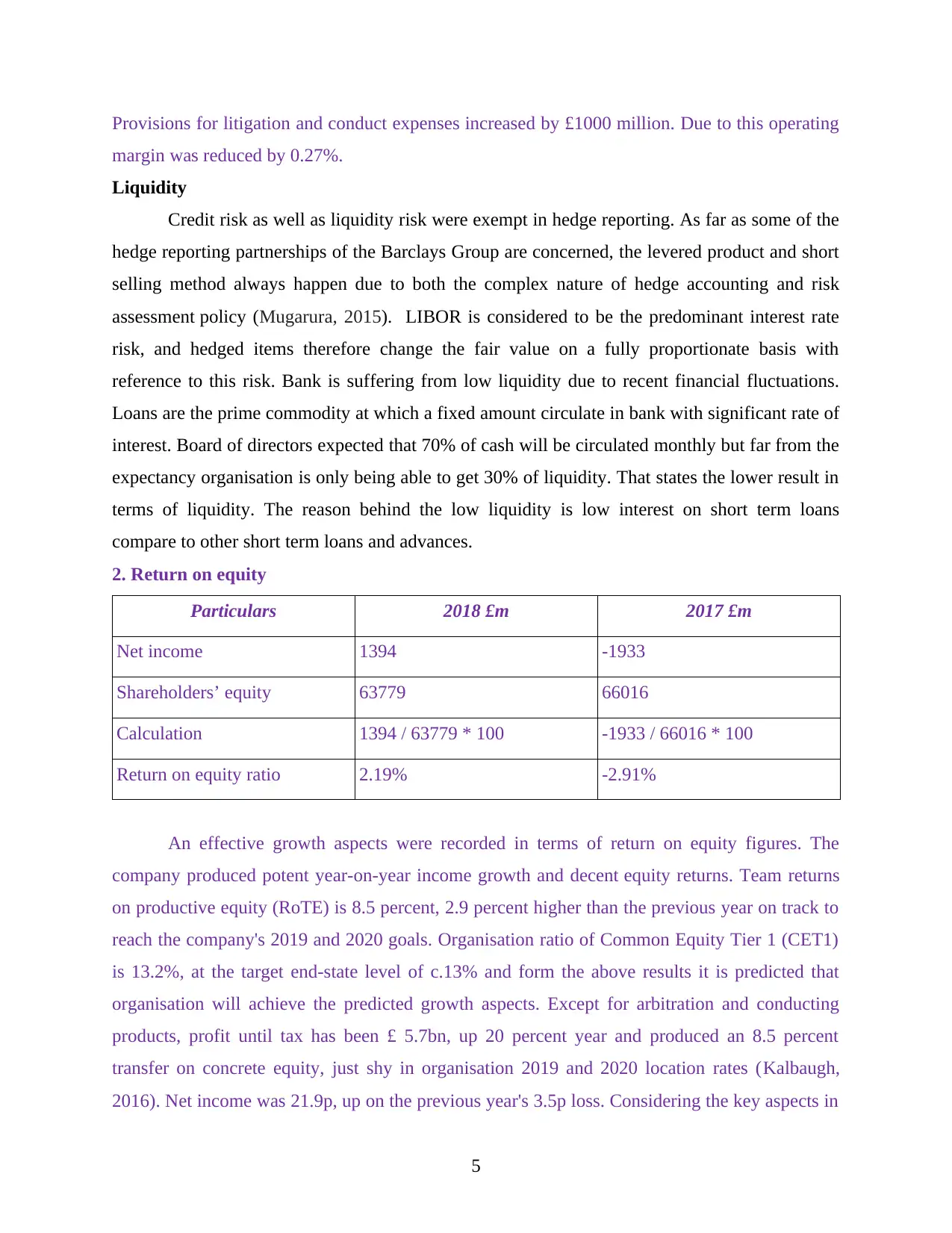
Provisions for litigation and conduct expenses increased by £1000 million. Due to this operating
margin was reduced by 0.27%.
Liquidity
Credit risk as well as liquidity risk were exempt in hedge reporting. As far as some of the
hedge reporting partnerships of the Barclays Group are concerned, the levered product and short
selling method always happen due to both the complex nature of hedge accounting and risk
assessment policy (Mugarura, 2015). LIBOR is considered to be the predominant interest rate
risk, and hedged items therefore change the fair value on a fully proportionate basis with
reference to this risk. Bank is suffering from low liquidity due to recent financial fluctuations.
Loans are the prime commodity at which a fixed amount circulate in bank with significant rate of
interest. Board of directors expected that 70% of cash will be circulated monthly but far from the
expectancy organisation is only being able to get 30% of liquidity. That states the lower result in
terms of liquidity. The reason behind the low liquidity is low interest on short term loans
compare to other short term loans and advances.
2. Return on equity
Particulars 2018 £m 2017 £m
Net income 1394 -1933
Shareholders’ equity 63779 66016
Calculation 1394 / 63779 * 100 -1933 / 66016 * 100
Return on equity ratio 2.19% -2.91%
An effective growth aspects were recorded in terms of return on equity figures. The
company produced potent year-on-year income growth and decent equity returns. Team returns
on productive equity (RoTE) is 8.5 percent, 2.9 percent higher than the previous year on track to
reach the company's 2019 and 2020 goals. Organisation ratio of Common Equity Tier 1 (CET1)
is 13.2%, at the target end-state level of c.13% and form the above results it is predicted that
organisation will achieve the predicted growth aspects. Except for arbitration and conducting
products, profit until tax has been £ 5.7bn, up 20 percent year and produced an 8.5 percent
transfer on concrete equity, just shy in organisation 2019 and 2020 location rates (Kalbaugh,
2016). Net income was 21.9p, up on the previous year's 3.5p loss. Considering the key aspects in
5
margin was reduced by 0.27%.
Liquidity
Credit risk as well as liquidity risk were exempt in hedge reporting. As far as some of the
hedge reporting partnerships of the Barclays Group are concerned, the levered product and short
selling method always happen due to both the complex nature of hedge accounting and risk
assessment policy (Mugarura, 2015). LIBOR is considered to be the predominant interest rate
risk, and hedged items therefore change the fair value on a fully proportionate basis with
reference to this risk. Bank is suffering from low liquidity due to recent financial fluctuations.
Loans are the prime commodity at which a fixed amount circulate in bank with significant rate of
interest. Board of directors expected that 70% of cash will be circulated monthly but far from the
expectancy organisation is only being able to get 30% of liquidity. That states the lower result in
terms of liquidity. The reason behind the low liquidity is low interest on short term loans
compare to other short term loans and advances.
2. Return on equity
Particulars 2018 £m 2017 £m
Net income 1394 -1933
Shareholders’ equity 63779 66016
Calculation 1394 / 63779 * 100 -1933 / 66016 * 100
Return on equity ratio 2.19% -2.91%
An effective growth aspects were recorded in terms of return on equity figures. The
company produced potent year-on-year income growth and decent equity returns. Team returns
on productive equity (RoTE) is 8.5 percent, 2.9 percent higher than the previous year on track to
reach the company's 2019 and 2020 goals. Organisation ratio of Common Equity Tier 1 (CET1)
is 13.2%, at the target end-state level of c.13% and form the above results it is predicted that
organisation will achieve the predicted growth aspects. Except for arbitration and conducting
products, profit until tax has been £ 5.7bn, up 20 percent year and produced an 8.5 percent
transfer on concrete equity, just shy in organisation 2019 and 2020 location rates (Kalbaugh,
2016). Net income was 21.9p, up on the previous year's 3.5p loss. Considering the key aspects in
5
Paraphrase This Document
Need a fresh take? Get an instant paraphrase of this document with our AI Paraphraser
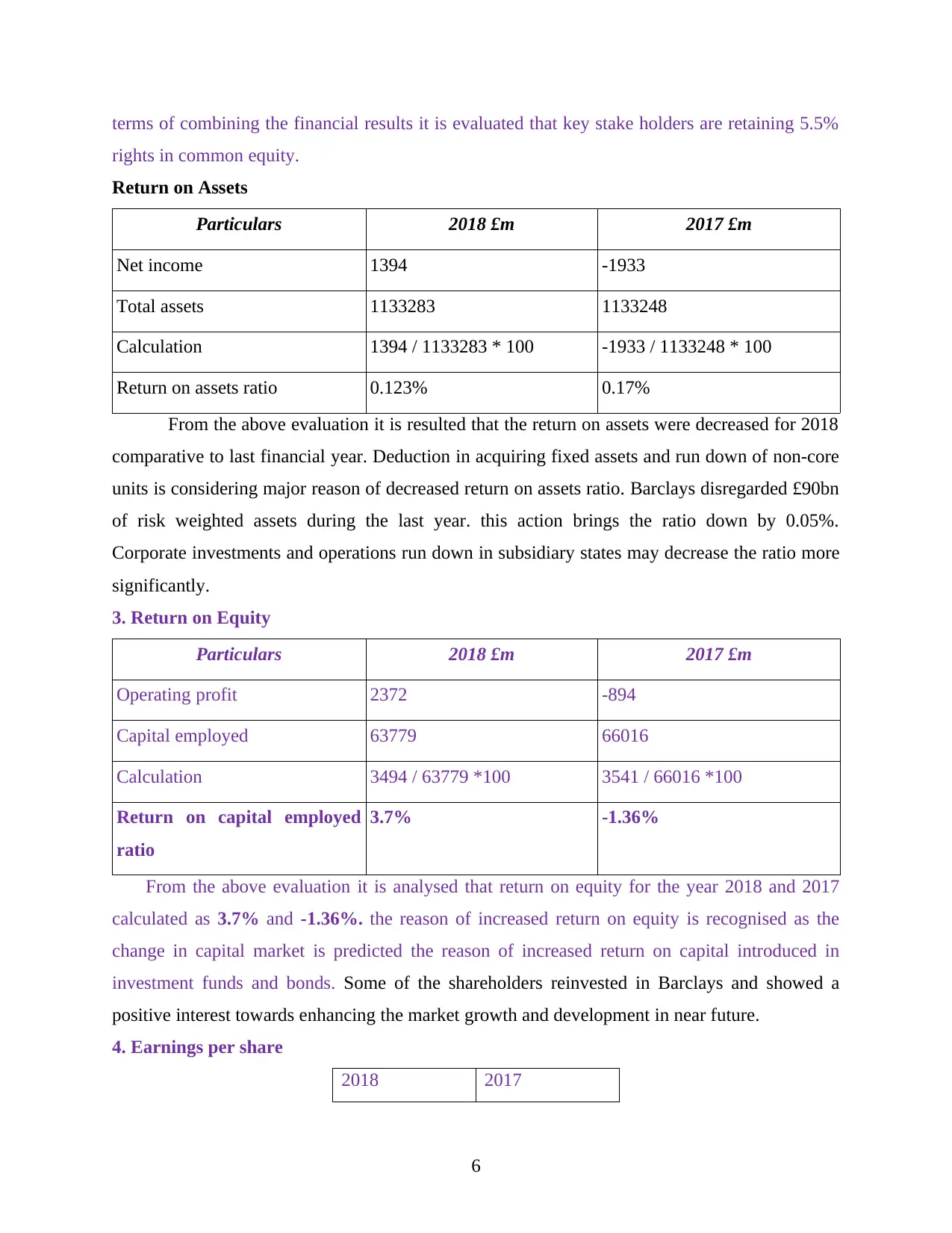
terms of combining the financial results it is evaluated that key stake holders are retaining 5.5%
rights in common equity.
Return on Assets
Particulars 2018 £m 2017 £m
Net income 1394 -1933
Total assets 1133283 1133248
Calculation 1394 / 1133283 * 100 -1933 / 1133248 * 100
Return on assets ratio 0.123% 0.17%
From the above evaluation it is resulted that the return on assets were decreased for 2018
comparative to last financial year. Deduction in acquiring fixed assets and run down of non-core
units is considering major reason of decreased return on assets ratio. Barclays disregarded £90bn
of risk weighted assets during the last year. this action brings the ratio down by 0.05%.
Corporate investments and operations run down in subsidiary states may decrease the ratio more
significantly.
3. Return on Equity
Particulars 2018 £m 2017 £m
Operating profit 2372 -894
Capital employed 63779 66016
Calculation 3494 / 63779 *100 3541 / 66016 *100
Return on capital employed
ratio
3.7% -1.36%
From the above evaluation it is analysed that return on equity for the year 2018 and 2017
calculated as 3.7% and -1.36%. the reason of increased return on equity is recognised as the
change in capital market is predicted the reason of increased return on capital introduced in
investment funds and bonds. Some of the shareholders reinvested in Barclays and showed a
positive interest towards enhancing the market growth and development in near future.
4. Earnings per share
2018 2017
6
rights in common equity.
Return on Assets
Particulars 2018 £m 2017 £m
Net income 1394 -1933
Total assets 1133283 1133248
Calculation 1394 / 1133283 * 100 -1933 / 1133248 * 100
Return on assets ratio 0.123% 0.17%
From the above evaluation it is resulted that the return on assets were decreased for 2018
comparative to last financial year. Deduction in acquiring fixed assets and run down of non-core
units is considering major reason of decreased return on assets ratio. Barclays disregarded £90bn
of risk weighted assets during the last year. this action brings the ratio down by 0.05%.
Corporate investments and operations run down in subsidiary states may decrease the ratio more
significantly.
3. Return on Equity
Particulars 2018 £m 2017 £m
Operating profit 2372 -894
Capital employed 63779 66016
Calculation 3494 / 63779 *100 3541 / 66016 *100
Return on capital employed
ratio
3.7% -1.36%
From the above evaluation it is analysed that return on equity for the year 2018 and 2017
calculated as 3.7% and -1.36%. the reason of increased return on equity is recognised as the
change in capital market is predicted the reason of increased return on capital introduced in
investment funds and bonds. Some of the shareholders reinvested in Barclays and showed a
positive interest towards enhancing the market growth and development in near future.
4. Earnings per share
2018 2017
6
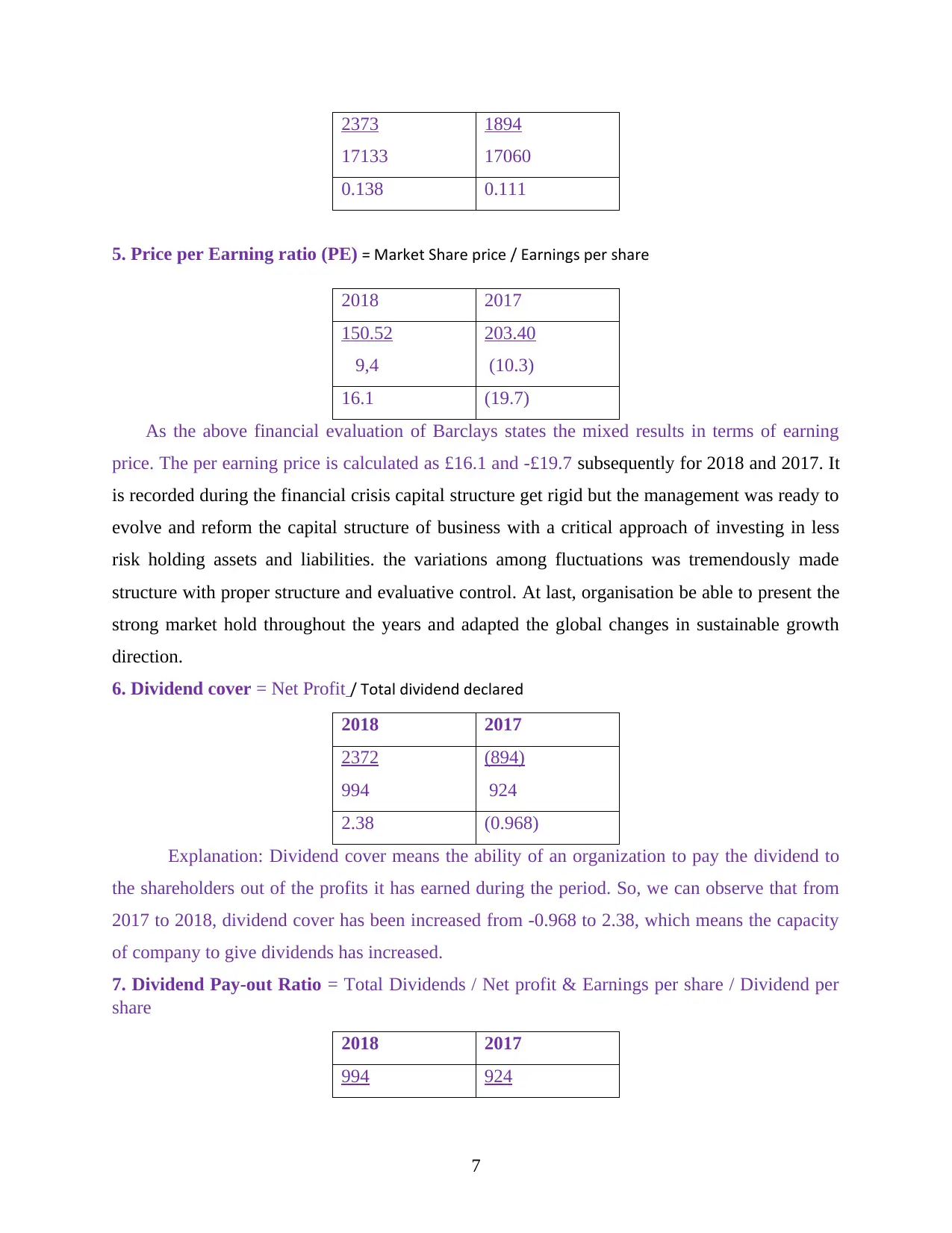
2373
17133
1894
17060
0.138 0.111
5. Price per Earning ratio (PE) = Market Share price / Earnings per share
2018 2017
150.52
9,4
203.40
(10.3)
16.1 (19.7)
As the above financial evaluation of Barclays states the mixed results in terms of earning
price. The per earning price is calculated as £16.1 and -£19.7 subsequently for 2018 and 2017. It
is recorded during the financial crisis capital structure get rigid but the management was ready to
evolve and reform the capital structure of business with a critical approach of investing in less
risk holding assets and liabilities. the variations among fluctuations was tremendously made
structure with proper structure and evaluative control. At last, organisation be able to present the
strong market hold throughout the years and adapted the global changes in sustainable growth
direction.
6. Dividend cover = Net Profit / Total dividend declared
2018 2017
2372
994
(894)
924
2.38 (0.968)
Explanation: Dividend cover means the ability of an organization to pay the dividend to
the shareholders out of the profits it has earned during the period. So, we can observe that from
2017 to 2018, dividend cover has been increased from -0.968 to 2.38, which means the capacity
of company to give dividends has increased.
7. Dividend Pay-out Ratio = Total Dividends / Net profit & Earnings per share / Dividend per
share
2018 2017
994 924
7
17133
1894
17060
0.138 0.111
5. Price per Earning ratio (PE) = Market Share price / Earnings per share
2018 2017
150.52
9,4
203.40
(10.3)
16.1 (19.7)
As the above financial evaluation of Barclays states the mixed results in terms of earning
price. The per earning price is calculated as £16.1 and -£19.7 subsequently for 2018 and 2017. It
is recorded during the financial crisis capital structure get rigid but the management was ready to
evolve and reform the capital structure of business with a critical approach of investing in less
risk holding assets and liabilities. the variations among fluctuations was tremendously made
structure with proper structure and evaluative control. At last, organisation be able to present the
strong market hold throughout the years and adapted the global changes in sustainable growth
direction.
6. Dividend cover = Net Profit / Total dividend declared
2018 2017
2372
994
(894)
924
2.38 (0.968)
Explanation: Dividend cover means the ability of an organization to pay the dividend to
the shareholders out of the profits it has earned during the period. So, we can observe that from
2017 to 2018, dividend cover has been increased from -0.968 to 2.38, which means the capacity
of company to give dividends has increased.
7. Dividend Pay-out Ratio = Total Dividends / Net profit & Earnings per share / Dividend per
share
2018 2017
994 924
7
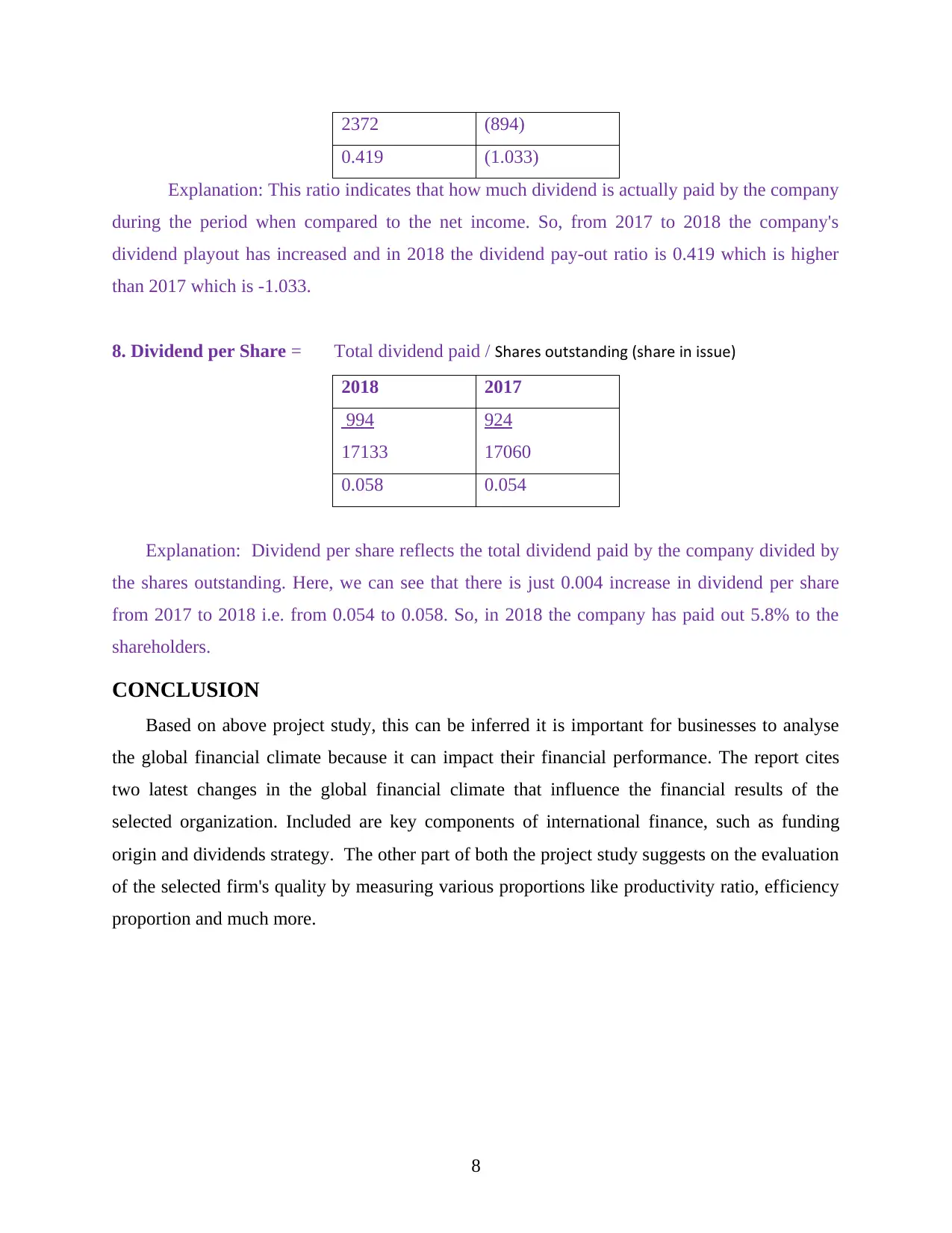
2372 (894)
0.419 (1.033)
Explanation: This ratio indicates that how much dividend is actually paid by the company
during the period when compared to the net income. So, from 2017 to 2018 the company's
dividend playout has increased and in 2018 the dividend pay-out ratio is 0.419 which is higher
than 2017 which is -1.033.
8. Dividend per Share = Total dividend paid / Shares outstanding (share in issue)
2018 2017
994
17133
924
17060
0.058 0.054
Explanation: Dividend per share reflects the total dividend paid by the company divided by
the shares outstanding. Here, we can see that there is just 0.004 increase in dividend per share
from 2017 to 2018 i.e. from 0.054 to 0.058. So, in 2018 the company has paid out 5.8% to the
shareholders.
CONCLUSION
Based on above project study, this can be inferred it is important for businesses to analyse
the global financial climate because it can impact their financial performance. The report cites
two latest changes in the global financial climate that influence the financial results of the
selected organization. Included are key components of international finance, such as funding
origin and dividends strategy. The other part of both the project study suggests on the evaluation
of the selected firm's quality by measuring various proportions like productivity ratio, efficiency
proportion and much more.
8
0.419 (1.033)
Explanation: This ratio indicates that how much dividend is actually paid by the company
during the period when compared to the net income. So, from 2017 to 2018 the company's
dividend playout has increased and in 2018 the dividend pay-out ratio is 0.419 which is higher
than 2017 which is -1.033.
8. Dividend per Share = Total dividend paid / Shares outstanding (share in issue)
2018 2017
994
17133
924
17060
0.058 0.054
Explanation: Dividend per share reflects the total dividend paid by the company divided by
the shares outstanding. Here, we can see that there is just 0.004 increase in dividend per share
from 2017 to 2018 i.e. from 0.054 to 0.058. So, in 2018 the company has paid out 5.8% to the
shareholders.
CONCLUSION
Based on above project study, this can be inferred it is important for businesses to analyse
the global financial climate because it can impact their financial performance. The report cites
two latest changes in the global financial climate that influence the financial results of the
selected organization. Included are key components of international finance, such as funding
origin and dividends strategy. The other part of both the project study suggests on the evaluation
of the selected firm's quality by measuring various proportions like productivity ratio, efficiency
proportion and much more.
8
Secure Best Marks with AI Grader
Need help grading? Try our AI Grader for instant feedback on your assignments.
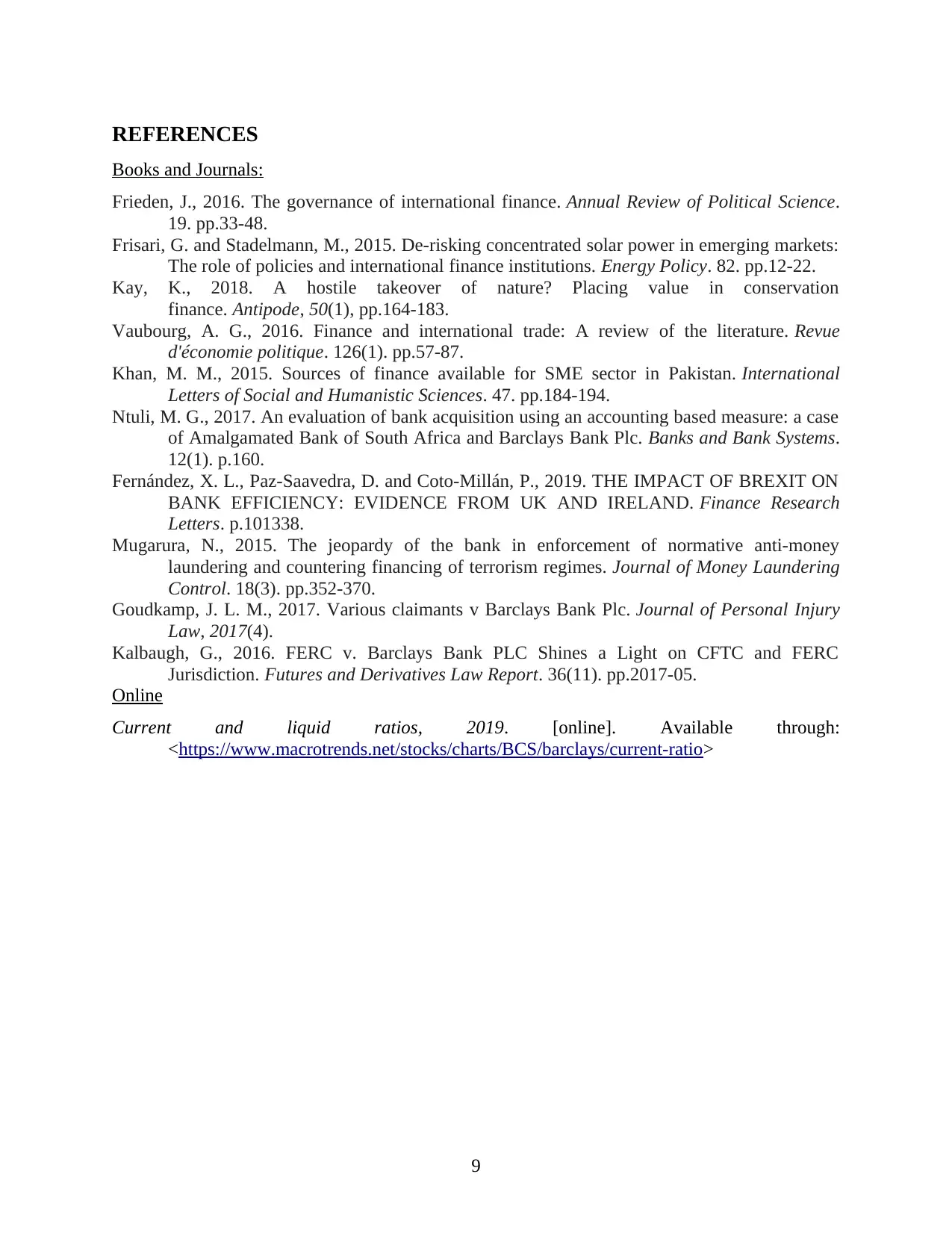
REFERENCES
Books and Journals:
Frieden, J., 2016. The governance of international finance. Annual Review of Political Science.
19. pp.33-48.
Frisari, G. and Stadelmann, M., 2015. De-risking concentrated solar power in emerging markets:
The role of policies and international finance institutions. Energy Policy. 82. pp.12-22.
Kay, K., 2018. A hostile takeover of nature? Placing value in conservation
finance. Antipode, 50(1), pp.164-183.
Vaubourg, A. G., 2016. Finance and international trade: A review of the literature. Revue
d'économie politique. 126(1). pp.57-87.
Khan, M. M., 2015. Sources of finance available for SME sector in Pakistan. International
Letters of Social and Humanistic Sciences. 47. pp.184-194.
Ntuli, M. G., 2017. An evaluation of bank acquisition using an accounting based measure: a case
of Amalgamated Bank of South Africa and Barclays Bank Plc. Banks and Bank Systems.
12(1). p.160.
Fernández, X. L., Paz-Saavedra, D. and Coto-Millán, P., 2019. THE IMPACT OF BREXIT ON
BANK EFFICIENCY: EVIDENCE FROM UK AND IRELAND. Finance Research
Letters. p.101338.
Mugarura, N., 2015. The jeopardy of the bank in enforcement of normative anti-money
laundering and countering financing of terrorism regimes. Journal of Money Laundering
Control. 18(3). pp.352-370.
Goudkamp, J. L. M., 2017. Various claimants v Barclays Bank Plc. Journal of Personal Injury
Law, 2017(4).
Kalbaugh, G., 2016. FERC v. Barclays Bank PLC Shines a Light on CFTC and FERC
Jurisdiction. Futures and Derivatives Law Report. 36(11). pp.2017-05.
Online
Current and liquid ratios, 2019. [online]. Available through:
<https://www.macrotrends.net/stocks/charts/BCS/barclays/current-ratio>
9
Books and Journals:
Frieden, J., 2016. The governance of international finance. Annual Review of Political Science.
19. pp.33-48.
Frisari, G. and Stadelmann, M., 2015. De-risking concentrated solar power in emerging markets:
The role of policies and international finance institutions. Energy Policy. 82. pp.12-22.
Kay, K., 2018. A hostile takeover of nature? Placing value in conservation
finance. Antipode, 50(1), pp.164-183.
Vaubourg, A. G., 2016. Finance and international trade: A review of the literature. Revue
d'économie politique. 126(1). pp.57-87.
Khan, M. M., 2015. Sources of finance available for SME sector in Pakistan. International
Letters of Social and Humanistic Sciences. 47. pp.184-194.
Ntuli, M. G., 2017. An evaluation of bank acquisition using an accounting based measure: a case
of Amalgamated Bank of South Africa and Barclays Bank Plc. Banks and Bank Systems.
12(1). p.160.
Fernández, X. L., Paz-Saavedra, D. and Coto-Millán, P., 2019. THE IMPACT OF BREXIT ON
BANK EFFICIENCY: EVIDENCE FROM UK AND IRELAND. Finance Research
Letters. p.101338.
Mugarura, N., 2015. The jeopardy of the bank in enforcement of normative anti-money
laundering and countering financing of terrorism regimes. Journal of Money Laundering
Control. 18(3). pp.352-370.
Goudkamp, J. L. M., 2017. Various claimants v Barclays Bank Plc. Journal of Personal Injury
Law, 2017(4).
Kalbaugh, G., 2016. FERC v. Barclays Bank PLC Shines a Light on CFTC and FERC
Jurisdiction. Futures and Derivatives Law Report. 36(11). pp.2017-05.
Online
Current and liquid ratios, 2019. [online]. Available through:
<https://www.macrotrends.net/stocks/charts/BCS/barclays/current-ratio>
9
1 out of 11
Related Documents
Your All-in-One AI-Powered Toolkit for Academic Success.
+13062052269
info@desklib.com
Available 24*7 on WhatsApp / Email
![[object Object]](/_next/static/media/star-bottom.7253800d.svg)
Unlock your academic potential
© 2024 | Zucol Services PVT LTD | All rights reserved.





